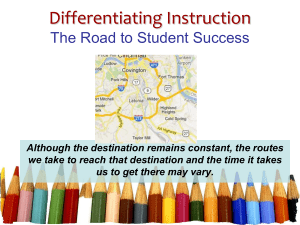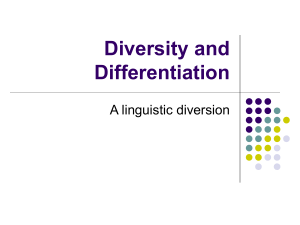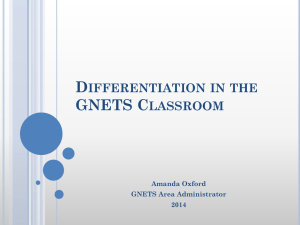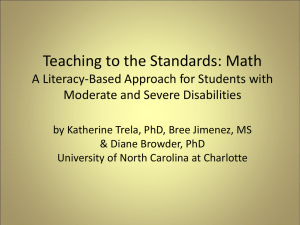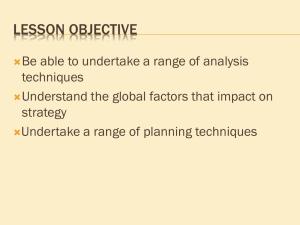Differentiation Isn*t... - Differentiated instruction, curriculum
advertisement
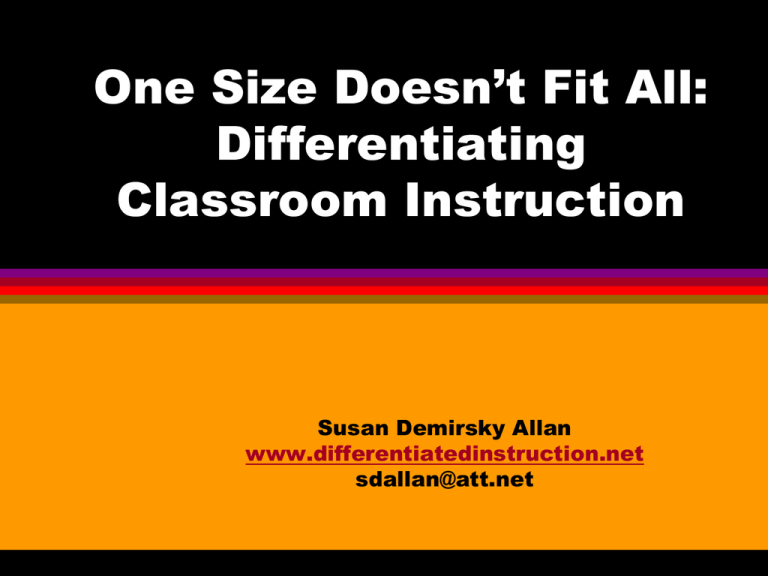
One Size Doesn’t Fit All: Differentiating Classroom Instruction Susan Demirsky Allan www.differentiatedinstruction.net sdallan@att.net Goals for the Day By the end of the day, you’ll be able to: Identify key features of an effectively differentiated classroom Explain some of the concepts and principles of differentiated instruction Analyze some lessons that differentiate by readiness using a key technique: tiered lessons Relate a number of examples of differentiation at work in a classroom 2 Differentiation is... ...the recognition of and commitment to plan for student differences. A differentiated classroom provides different avenues to acquire content, to process or make sense of information and ideas, and to develop products. 3 The Goals... ... of a differentiated classroom are to maximize student growth and to promote individual student success. 4 Basic Understandings The increasing diversity of students requires an alternative to the one-size-fits-all approach to heterogeneous classrooms. Educating all our students requires clear commitment to gifted and special education students, as well as those students whose performance is more “typical”. There should be no walls and no ceilings to learning. 5 Clearing Up a Common Misunderstanding Differentiation uses flexible grouping. Teachers implement flexible grouping strategies that cluster students by achievement in a particular subject area, interest, learning style, personal choice, and/or ability. The key is flexible. Teachers move students in and out of groups after assessing students’ instructional needs. 6 Some Basic Principles We differentiate instruction when we use a variety of instructional techniques that enable us to meet the diverse learning needs of our students. It is not the cumbersome technique of individualization. It can be thought of as grouped individualization. 7 Differentiation is… Providing multiple assignments within each unit, tailored for students of different levels of readiness, interest, and/or learning style Having high expectations for all students. Aim high and differentiate down as necessary. 8 Differentiation is… Permitting students to opt out of material they can demonstrate they know and to progress at their own pace through new material. 9 Differentiation is… Allowing students to choose, with the teacher’s guidance, ways to learn and to demonstrate what they have learned. (Keep in mind, it’s with the teacher’s guidance. The teacher has the final word!) 10 Differentiation is… Providing students with opportunities to explore topics in which they have strong interest and find personal meaning. Implementing flexible grouping strategies that cluster students by achievement in a particular subject area, interest, learning style, personal choice, and/or ability. 11 Differentiation isn’t... Individualization. It isn’t a different lesson plan for each student each day. Giving all students the same work most of the time, even in achievement or ability grouped classes. 12 Differentiation isn’t… Requiring students to teach material that they have already mastered to others who have not yet obtained mastery. Assigning more math problems or more reading at the same level to high achieving students. Focusing on student weaknesses and ignoring student strengths. 13 A Picture is Worth A Thousand Words Differentiation in Action: Snapshots of Tiered Lessons in Different Grades and Subjects Instructional Strategies tiered activities and/or products adjusted processes in activities learning contracts independent study adjusted questions compacting 15 A middle school science project used almost identical activities but some groups of students did the activities on elements and some on compounds. 16 A simple tiered activity Grade K: Counting (skill) • Task 1 Find a way to count and show how many people are in our class today. – How did you get your answer? • Task 2 Find a way to show how many people are in our class. – How many are absent today? – How many are here today? – How do you know? • Task 3 Find a way to show how many boys are in our class today. – – – – How many boys are absent today? How many girls are here today? How many girls are absent today? Prove you are right. 17 Grade K: Key Concept: Patterns • Generalization: Scientists make classifications. – Use carpenter’s aprons to collect “data” through a nature walk. Then, at the science center: • Task 1 Using a pre-made grid with categories on it, classify leaves: • by size • by color • Task 2 Display a sample grid and have students create their own. Classify leaves: by shape • by creating a category • Task 3 Students decide how to show categories and contents • Find 3 ways each leaf could be classified – other than color. 18 “Tweak” an existing lesson to create two or three different tasks that all achieve the same objective. Sample GLCE: ◦ N.ME.06.06 Represent rational numbers as fractions or terminating decimals when possible, and translate between these representations. Easy task: What is 3/4 as a decimal? Mid-level task: What is 3/5 as a decimal? Difficult task: What is 1 3/8 as a decimal? 19 OR COMPLEX 20 GLCE: N.MR.06.13 Solve contextual problems involving percentages such as sales taxes and tips. The music store is having a sale. Every day this month, the store is offering a 10% discount on all CDs and CD singles. You have $25 to spend on CDs and CD singles. Buy as many as you’d like with the money you have. Make a list of the CDs and CD singles you buy, and how much they cost after the discount. Remember to add on 6% sales tax! 21 The music store is having a sale. Every day this month, the store is offering a 25% discount on all CDs and CD singles. You have $45 to spend on CDs and CD singles. Buy as many as you’d like with the money you have. Make a list of the CDs and CD singles you buy, and how much they cost after the discount. Remember to add on 6% sales tax! 22 The music store is having a sale. Every day this month, the store is offering a 25% discount on all CDs and CD singles. You have $45 to spend on CDs and CD singles. Buy as many as you’d like with the money you have. Make a list of the CDs and CD singles you buy, and how much they cost after the discount. Remember to add on 4.5% sales tax! 23 At the beginning of the year, have the students complete a Learning Styles Inventory. Use this information to determine which students should get ◦ visual instruction (either from a video tutorial or the book) ◦ auditory instruction (either from you, a video tutorial or a podcast) ◦ tactile/kinesthetic instruction (e.g., using manipulatives) Some students grasp the abstract concept quickly and prefer not to use manipulatives at all. But kinesthetic learners love them! Developed by Jennifer H. Allan, Birmingham Public School System The teacher uses the same lesson but some students work with the actual manipulatives (tactile learners) with virtual manipulatives (visual learners) don’t work with the manipulatives at all, but may hear an explanation or see a video (auditory learners) or work with the abstract symbols (advanced learners/abstract thinkers) 25 Example: Chip Boards for teaching Integer Addition and Subtraction Tactile model involves a flat “board” (usually cardboard) and red and black chips. Virtual model available at the National Library of Virtual Manipulatives (www.nlvm.usu.edu) ***Caveat – students love the virtual chip boards and usually will not go back to the tactile version! National Library of Virtual Manipulatives (http://nlvm.usu.edu/) NCTM website (http://illuminations.nctm.org/ 27 A. B. Why did Max go to visit the wild things? Do you think that was a good or bad idea? Why did he decide to come home? Was that a good or bad idea? Why do you say so? If you were Max’s Mom or Dad, write about what you would think when he went to his room, when he went where the wild things were, when he came home? 28 C. D. Max sometimes talks to himself. Tell us what he says when he goes to his room, goes through his visit to the wild things, decides to come home and gets back to his room. What do he and his parents say the next morning? What does it really mean to go where the wild things are? Tell a story about a time when that happened to you or a friend. Tell enough so we can see how the two stories are alike or different. 29 DEAR MOM AND DAD Welcome to parent conferencing night. My teacher and I have developed the following report so that you will know what I am working on in (subject area) this term. We have some goals for our class this term. They include the following: Academic: Work Ethic: _______________________________ _______________________________ _______________________________ _______________________________ _______________________________ _______________________________ _______________________________ _______________________________ _______________________________ _______________________________ 30 DEAR MOM AND DAD (CON’T) In addition, my teacher has differentiated these goals for me and a group of my learning partners in this way: Academic: Work Ethic: _______________________________ _______________________________ _______________________________ _______________________________ _______________________________ _______________________________ _______________________________ _______________________________ _______________________________ _______________________________ 31 DEAR MOM AND DAD (CON’T) In discussion with my teacher, I’ve also decided on the following personal goals: Academic: Work Ethic: _______________________________ _______________________________ _______________________________ _______________________________ _______________________________ _______________________________ _______________________________ _______________________________ _______________________________ _______________________________ 32 DEAR MOM AND DAD (CON’T) I would like your help in accomplishing my goals by: ___________________________________________________ _________________________________________________ _________________________________________________ ______ Thanks, Your son or daughter 33 Compacting Useful for students who: Are reading at an advanced level Finish tasks quickly Would benefit from more advanced work. Good site for information: http://www.gifted.uconn.edu/sem/p df/Curriculum_Compacting.pdf 34 Curriculum Compacting Pre-Test everyone (all students are given equal opportunities to demonstrate knowledge) Give a Post-Test to those students who pass the pre-test If a student passes the Post-Test as well, demonstrating mastery, they can “opt out” of the unit. 35

